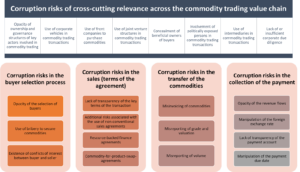
This project investigates corruption in the commodity trading sector, focusing on on three emerging developments in the industry, through which both long-standing corruption trends and new risks and opportunities can be examined: food insecurity, the climate transition, and the rise of blockchain.
Project Summary
In the commodities sector, state structures create a compounded challenge: resource-rich countries with weak rule of law and limited state accountability. This has made the sector fertile soil for multiple forms of corruption, including bribery, kickbacks, mispricing, embezzlement, and trade-based money laundering (TBML). Furthermore, the rise of populism and isolationism have led to fragmentation of the global multilateral order, thus inhibiting cooperation and joint efforts to control corruption.
The past two decades have witnessed growing concern about aligning the opportunities from global trade with the challenges governments face in regulating multinational commerce. Pressing social and environmental challenges further compound the need for global accountability, especially for multinational businesses. This research project analyses the various corruption risks, assesses their impact with multidisciplinary methodologies, and delves into the underlying drivers of these trends.
Policy and Programming Implications
Although commodity trading is exposed to several types of corruption, bribery is the most widely studied, in part because it is the easiest offence to prosecute (1). Commodity trading is also subject to other forms of corruption that are more difficult to prevent and prosecute, and are thus less well understood.
This includes inappropriate participation by political elites, industry actors (including lawyers, realtors, accountants, and investment advisors) who exercise influence over policymaking and regulatory decisions (and may enable oligarchy, dictatorship or human rights violations), as well as private companies that buy and sell commodities sourced from such regimes (mostly located in high-income nations in Europe and North America) (2).
Figure 1: Typology of corruption risks in commodity trading (3)
Commodity trading, as a form of international trade, is subject to trade-related corruption, such as trade-based money laundering and mispricing. In this rapidly changing context, forward-looking policy-relevant research priorities must focus on transformational trends and how they intersect with corruption in global trade. Corruption across multiple sites, with a range of actors who may not even know each other, is increasingly recognized as a complex system. This requires anti-corruption actors to utilise creative collaboration with multiple leverage points.
Research Questions
- What new corruption risks stem from the ongoing climate transition and the resulting large-scale green energy development projects?
- What new corruption risks or anti-corruption opportunities are presented by the rise of cryptocurrency and the use of blockchain technology in global trade and illicit economies?
- What is the impact on corruption of supply chain tracking and other integrity technology in global trade?
- How might corruption risks in the CTC sector be accelerated by ongoing shocks to global food security due to the war in Ukraine or other disruptive events?
Methodology
The methodology will utilise a multidisciplinary review of the academic and policy literature on trade-related corruption: case studies from non-governmental organisations at the forefront of anti-corruption, scholarship explicitly focused on corruption, and literature on transnational business and trade economics. Given the diversity of the issues to be captured, the research team will take a balanced approach to evidence quality. This will include three methodologies: strength-of-evidence assessment criteria, an inductive incidence analysis (using media and regulatory databases), informant interviews with cross-sectoral focus groups. Throughout the process, the researchers will triangulate between the methodologies to contextualise the analysis.
Research Team Members
- Maha Rafi Atal, PhD, Lecturer in Global Economy (Politics), University of Glasgow
- Stephanie Trapnell, PhD, Affiliate Faculty, George Mason University
- Dieter Zinnbauer, PhD, Marie-Curie Post-Doctoral Research Fellow, Copenhagen Business School
(1) The most well-known instrument designed for this purpose is the U.S. Foreign Corrupt Practices Act, employed by the Department of Justice (DOJ), the Securities and Exchange Commission (SEC), and much more recently (beginning in 2022), the Commodities and Futures Trading Commission (CFTC). The U.K.’s 2010 Bribery Act is also notable, enforced by the newly established Serious Fraud Office (SFO).
(2) Frank Vogl, The Enablers: How the West Supports Kleptocrats and Corruption: Endangering Our Democracy (Lanham, Maryland: Rowman & Littlefield, an imprint of The Rowman & Littlefield Publishing Group, Inc, 2022).
(3) OECD. 2016. Corruption in the Extractive Value Chain: Typology of Risks, Mitigation Measures and Incentives. Paris: Organisation for Economic Co-operation and Development. https://www.oecd-ilibrary.org/development/corruption-in-the-extractive-value-chain_9789264256569-en



